
Link Prospecting Strategies to Dominate Link Building
Link prospecting is the act of finding relevant websites and people to reach out to. It's hands down the most important facet of link building.
Without having a strong link prospecting strategy in place, everything else immediately falls apart.
You must get this right for two reasons:
- You’ll increase your chances of getting a link
- You’ll ensure the link will be high quality.
Developing a link building strategy that works is absolutely vital. This article will go through all the steps you need to run an effective link prospecting campaign.
Key Takeaways
Link prospecting is searching for websites that may be willing to link to you.
It’s the first part of a link building outreach campaign.
Choosing the right websites to approach can have a serious impact on your campaign effectiveness.
You can find websites using search engines and SEO tools, and by analyzing your competitors’ links
What Is Link Prospecting?
Link prospecting is the process of identifying suitable websites to approach for your link building efforts. This usually means they’ll be in a relevant niche and meet your target domain authority.
Get link prospecting right, and you’ll end up with a long list of target websites that may be willing to link to yours. But find the wrong websites and you’ll struggle to generate links during the rest of your campaign.
A typical link prospecting strategy consists of three parts:
Choosing a link building strategy
Defining what your ideal targets look like
Creating a list of targets
Select a Link Building Strategy
The first step in any link prospecting campaign is to define the link building strategy you plan to use.
This is essential because your link building strategy influences the types of websites you prospect.
These are the three main types of link building that you need to prospect for:
Guest posting
Linkable asset campaigns
Link insertions
Here is more information about each of these techniques and how you need to adjust your prospecting strategy.

Guest posting
Guest posting is when you write articles for other websites and include outgoing links back to your site in the post.
All guest posting campaigns start with prospecting because first you need to find and contact websites to publish your posts.
When looking for suitable websites to publish guest posts on, answer these two questions.
Is the website high quality and in your target niche?
Are there signs that the website is open to publishing guest posts?
The first point is critical, because it ensures you generate quality links that have a good chance of impacting your rankings.
The second question is important because it’s easier to publish articles on websites with a track record of publishing guest posts. You could try to convince other websites to publish your guest post, but it might be difficult to do so.
There are two ways to identify when a website accepts article submissions:
- They advertise that they accept article submissions. These sites will typically have a page titled “Write for Us” or “Submit a Guest Post.”
- They publish posts from people who don't work at the company. Check the author box on the site’s recent posts to see if this is the case.
If a website shows either of these two signs, there’s a good chance it is open to publishing guest posts. If you're serious about prospecting for guest posts, check out this in-depth guide later.
Be Wary of Guest Post Farms
Guest post farms are websites that only publish paid guest posts. These are spam sites that earn money by charging for the posts they place on their websites. A link from one of these websites is unlikely to be worth the time or effort required to generate the link.
Linkable Asset Campaigns
A linkable asset campaign is when you create a high-quality piece of content and ask websites to link to it. It’s also known as the skyscraper link building strategy.
We regularly set up these types of campaigns within our agency, as they can yield some very strong relevant links.
Link prospecting is an essential part of a linkable asset campaign. That's because website owners can only link to content they know exists. If you don’t actively promote your asset via prospecting campaigns, you won’t be able to get it in front of others.
The key to effective linkable asset prospecting is to look for specific pages that will benefit from the asset you have published. You can then suggest that the prospect links to your article from this page.
For example:
If you create a report, look for pages that would benefit from linking to the findings. For example, when your report helps support the point the writer is trying to make, or if it includes more up-to-date data.
If you have new statistics, look for relevant statistics pages. Many websites publish lists of statistics in a particular niche or industry. They may be willing to add your research to their resources.
If you have created a tool, look for “best of” lists, resource pages, or blog posts that discuss topics that could benefit from your creation.
The idea is to make it as easy as possible for the website to link to your content. A site is more likely to link to your piece if all they have to do is add a link to an existing piece of content rather than creating a whole new article.
The issue with linkable assets is that it is a common strategy. This means the market is saturated.
To stand out, you need to ensure your content is incredibly high quality and genuinely useful.
Some Website Will Charge for a Link 💰
Paying for links is against Google guidelines. But it’s a relatively common practice in some industries.
If the website is high quality and publishes a lot of its own content, it may be worth paying up. Read this article for our thoughts on buying links.
Link Insertions
Link insertions is when you ask a website to link to a specific page on your site. Typically, you’ll pay the website owner to place the link.
You should be quite open when prospecting, as you’ll have to reach out to many websites to see results. The more websites you contact, the more likely it is that you’ll generate results
Start by looking for any relevant sites. Then narrow the list down based on the website’s authority.
You typically want to choose websites with at least a DA/DR of 30 to ensure you generate high-quality links that are likely to move the needle. It’s not typically worth paying for links on sites with a lower DR than this unless the price is really low.
In most cases you can also rule out websites with a DR of over 70, as these high-authority websites are highly unlikely to accept paid link requests.
The most important thing when building links using link insertions is to avoid spam websites.
Many low-quality websites and link farms sell links. But the links they provide are ineffective because Google knows about these sites and neutralizes any links they provide.
How to Spot a Spam Website 🕵️
Signs of a spam website include:
Low-quality content
A poorly designed website
No “About” or contact information
Little organic traffic according to SEO tools like Ahrefs
Lots of suspicious-looking outbound links
Posts not attributed to a particular author
You can read more about how to tell real websites from spam ones in this article.
Once you’ve completed step one, you should know what link building strategy you will use.
The next step in a link prospecting campaign is to define the types of websites you want to target.
The two biggest factors are:
The website’s niche
Its target domain authority
Here is an in-depth look at each of these steps.
How to Decide Which Niches to Target
The first thing to consider is the niche of the websites. Google values links from websites that publish content relevant to your site, so you should prioritize these link targets.
Most websites can target three types of relevant websites:
Those in your niche
Those in related niches
Those in the wider niche
Here’s an example for a luxury watch website.
Those in your niche: Other luxury watch websites.
Those in related niches: Websites that publish content about fashion, travel, and luxury living.
Those in the wider niche: Websites that publish e-commerce or general lifestyle content.
You just need to think about topics in the above categories that are related to your website. You can then make a list of the potential niches to target.

The Number of Link Opportunities Is Almost Endless 🚀
Thinking about link building in this way means even the smallest, most niche websites have an almost unlimited number of prospects. You just need to look for related opportunities and connect them back to your website.
Choose Your Target Metrics
You can also think about your target metrics such as;
- DR (domain rating)
- DA (domain authority) - you can check this score with a number of tools
- Organic Traffic - the amount of traffic a website gets each month
- Traffic Value - the value of a website's traffic each month - this is a great metric to weed out low quality sites
A general rule is that the higher a website's domain authority, the more impactful the link will be. But it is also typically harder to generate links from authoritative websites.
Here are some of the metrics we typically aim for:
- DR 40 - 80
- Organic Traffic 1,000+
- Traffic Value $1,000+
When running outreach campaigns, we typically aim for websites with a domain authority of between 40 and 80. This is a good range that will benefit most websites and generate good results.
If you have a brand-new website or are new to link building, you will benefit from targeting websites with a lower DA than this. At this early stage, almost any link on a quality website will help move the needle.
On the other hand, if your website already has a mid-to-high domain rating you should try to get links from higher-authority sites. Lower-authority links won’t provide much impact. Here are some of our favorite strategies you can use to generate authoritative links.
Be Wary of Domain Authority Metrics
Domain authority metrics can be a good way to tell the potential worth of a link. But these scores can be increased artificially.
People do this by buying an expired domain with an existing level of domain authority and redirecting it to their site.
Create Your Prospecting Lists
Now you know your strategy and the types of websites to target, you need to start building your links.
There are many strategies you can use to create a list of websites to target.
We like the following three methods:
Generating lists of websites from Google
Using Ahrefs Content Explorer to find websites
Analyzing competitor backlinks
These three strategies are an easy way to generate a large list of comprehensive targets.
Method 1 - Google Prospecting
This strategy can generate many outreach targets. And you don’t need any link prospecting tools to do it!
The way it works is that you search Google for specific search terms that result in link building opportunities.
Create a List of Search Terms with Advanced Search Operators
Google search operators are search terms you can use to perform advanced searches.
These are a useful tool for link building because they allow you to look for sites with particular characteristics.
A simple example is using the search operator “guest posts” to find websites that accept guest posts. Just search for your target niche followed by the term “guest posts” (including quotation marks) and Google will only show results that include this exact term.
See an example in the image below.
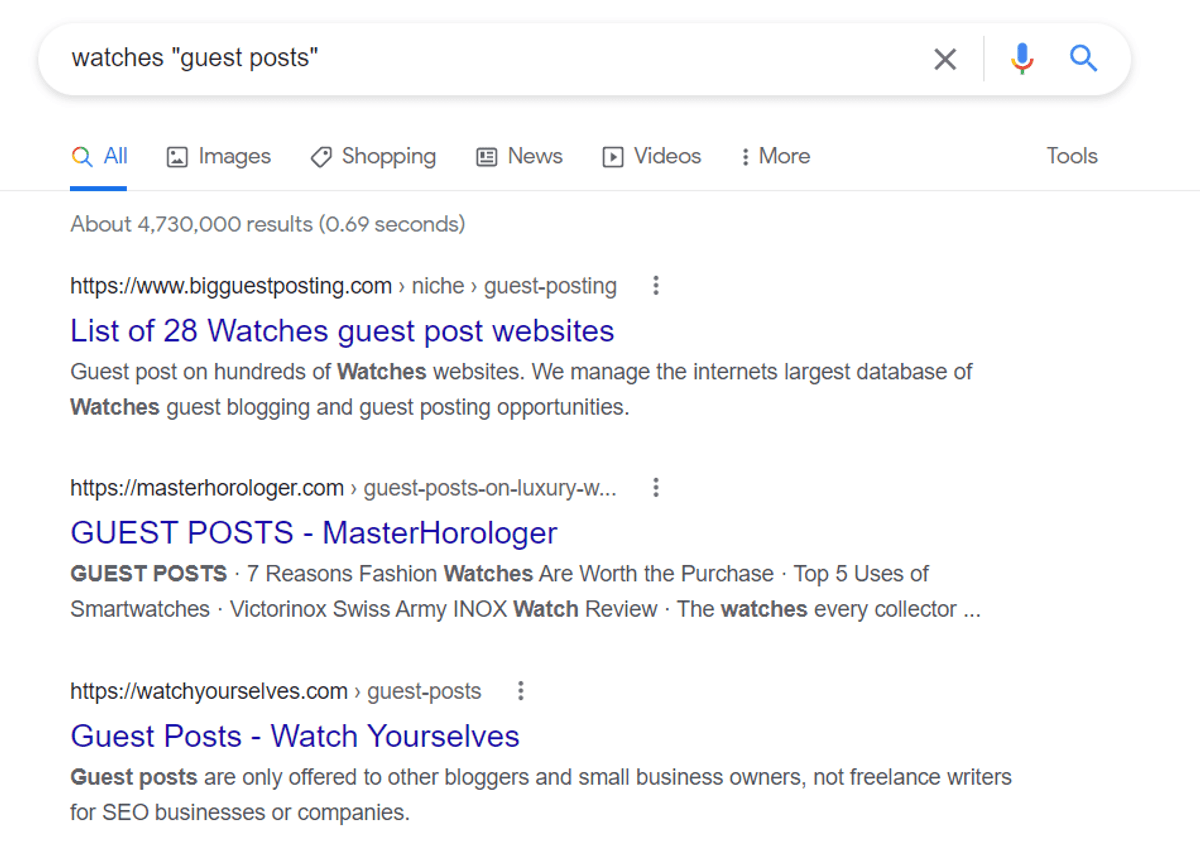
There are many operators you can use to find link building opportunities. Searching for each of these terms allows you to build up an extensive list of prospects.
We’ve even created a spreadsheet with a huge list of terms you can use to discover appropriate outreach targets.
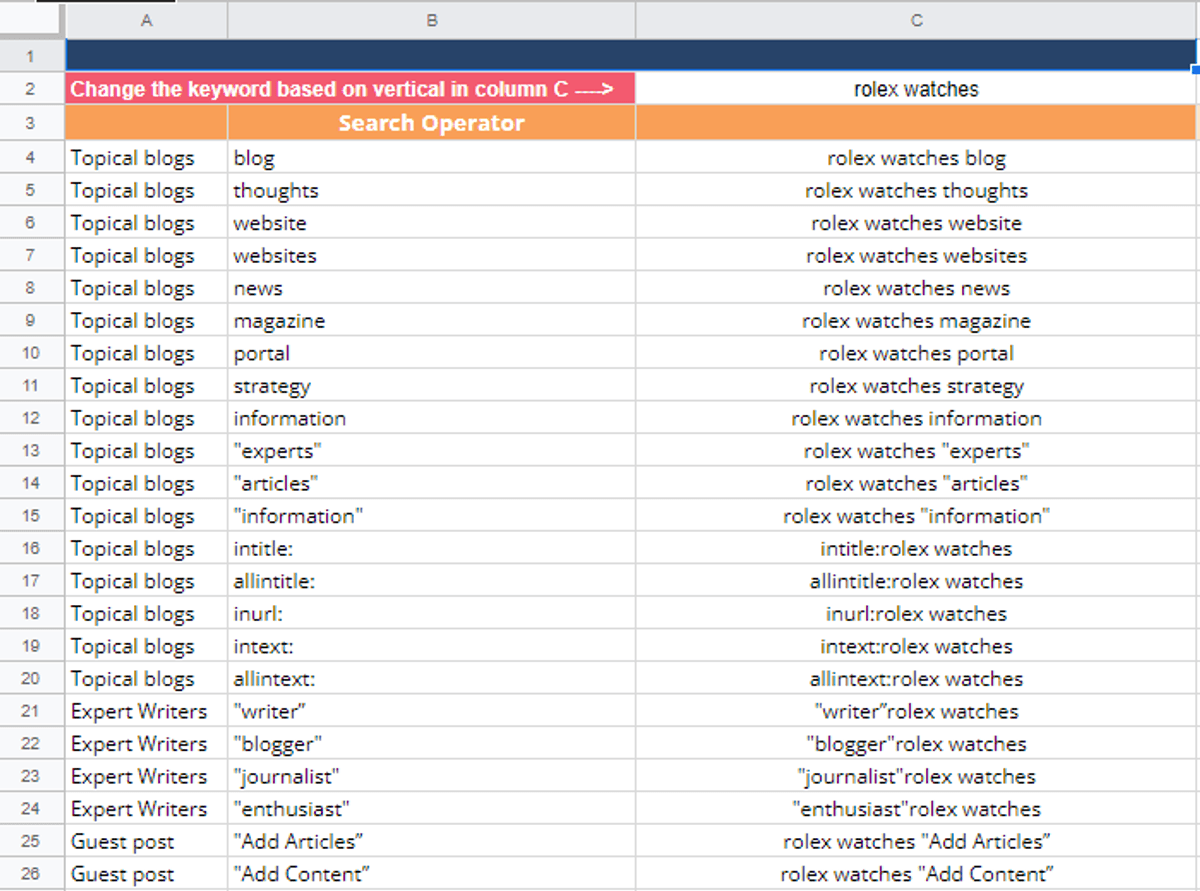
All you have to do is make a copy of the document and then change the search keyword “Rolex watches” into one of the niches of websites you want to target. You’ll end up with a ton of search terms you can use to find websites to reach out to.
We’ve even categorized the terms to highlight the type of opportunities they can generate. You can then match this to the link building strategy you chose in step one.
Add Your Results to a Spreadsheet
Once you've gone through all of the Google results, you can place your favorite link prospects into a spreadsheet which can then be uploaded to your outreach tool of choice.
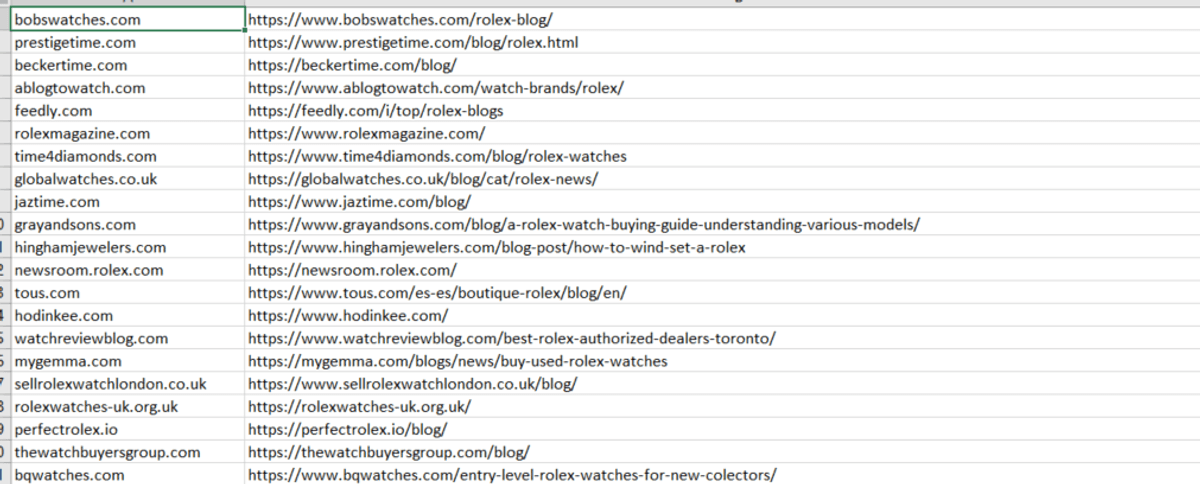
Turbo-Charge The Process
You can easily turbo-charge this process by immediately scraping the top 100 Google results and placing them into a spreadsheet in literally seconds.
Simply use this handy tool from LinkPitch and you'll have the results in a spreadsheet in no time at all.
Method 2 - Ahrefs Prospecting
The second way to build a prospecting list is to use Ahrefs Content Explorer.
This is a good way to discover websites that publish articles on topics relevant to your website.
The tool is super easy to use. Just head to the Content Explorer tab in your Ahrefs dashboard and then search for your relevant keyword.
The great things about this tool are the extra information you get about each domain and the filtering options.
For example, you can choose to only show websites within a particular domain rating (DR) range. This allows you to filter out both high-DR websites that you are unlikely to get a link from, and low-DR websites that aren’t worth targeting.
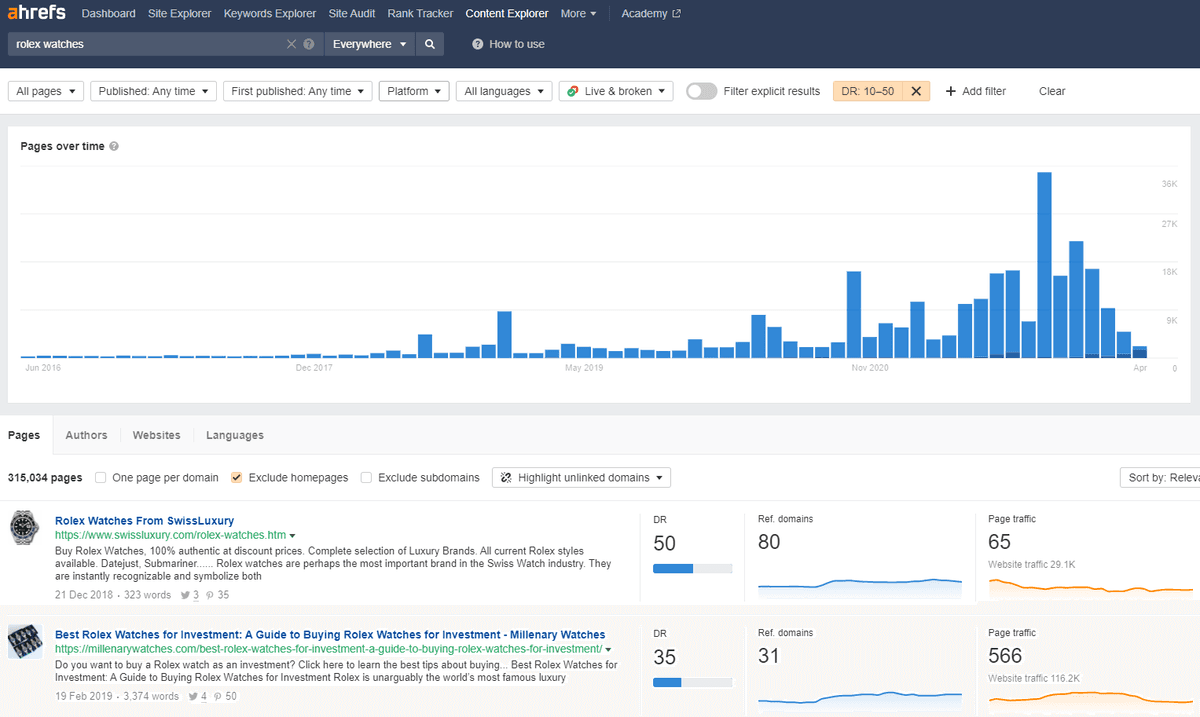
You can also adjust your search depending on your link building process.
For example, if you are using a skyscraper strategy you can filter the results to only show blog posts as this is the type of content most likely to link to you. Or you can only highlight recently published articles, as these are sites that you know are still active.
Once you’re happy with the results you can export them to a .csv file and view them in Excel. From here it’s easy to rule out any irrelevant websites.
An Example of This Strategy in Action 📈
This is the strategy we used when link prospecting for real estate CRM Follow Up Boss.
We were promoting an article that shared 13 lead gen ideas. We knew it would be interesting to websites that write about real estate marketing.
We used Ahrefs Content Explorer to find websites that publish content on this topic.
By searching for the content and then exporting it to a spreadsheet, we generated over 160 prospecting targets in under five minutes.
Read more about the strategies we used to build 494 links for Follow Up Boss here.
Method 3 - Find Competitor Links
Discovering your competitors’ links highlights websites that you know link to sites like yours.
And it’s an easy tactic to implement.
All you have to do is:
Identify content similar to the content you want to build links to
Put this content into an SEO tool to see which websites link to it
Make a list of all these websites
Here’s a quick example.
Imagine you own a website about luxury watches and you want to build links to a buying guide for Rolexes.
Searching for relevant terms in Ahrefs, for example “Rolex Buying Guide,” will show all the top-ranking websites.
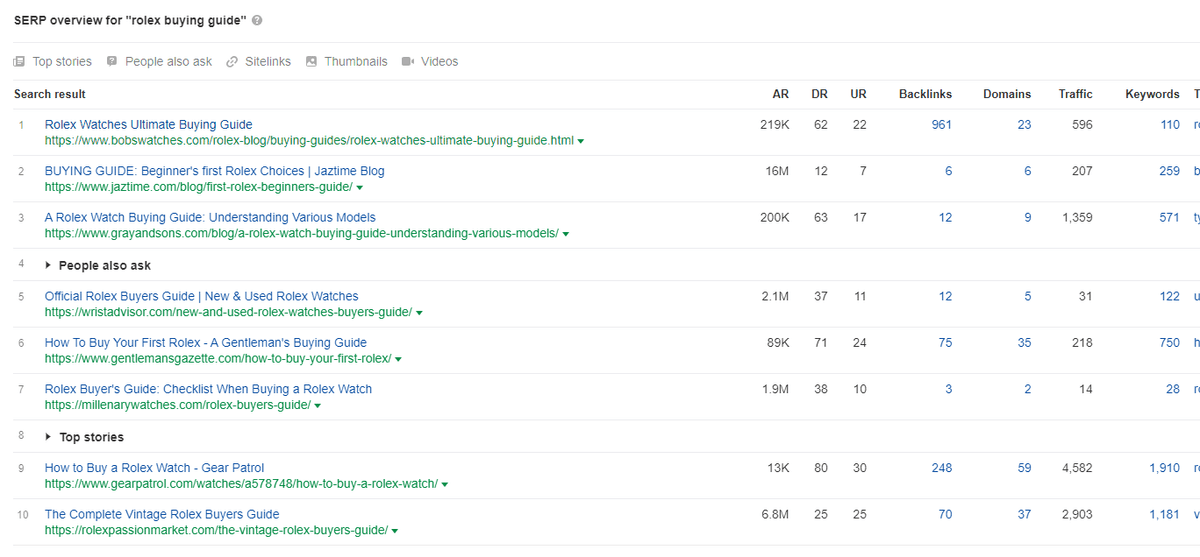
Look for the pages with the most links and then view all the referring domains. The image below shows the 25 domains that link to the number one ranked post for the term “Rolex buying guide.”
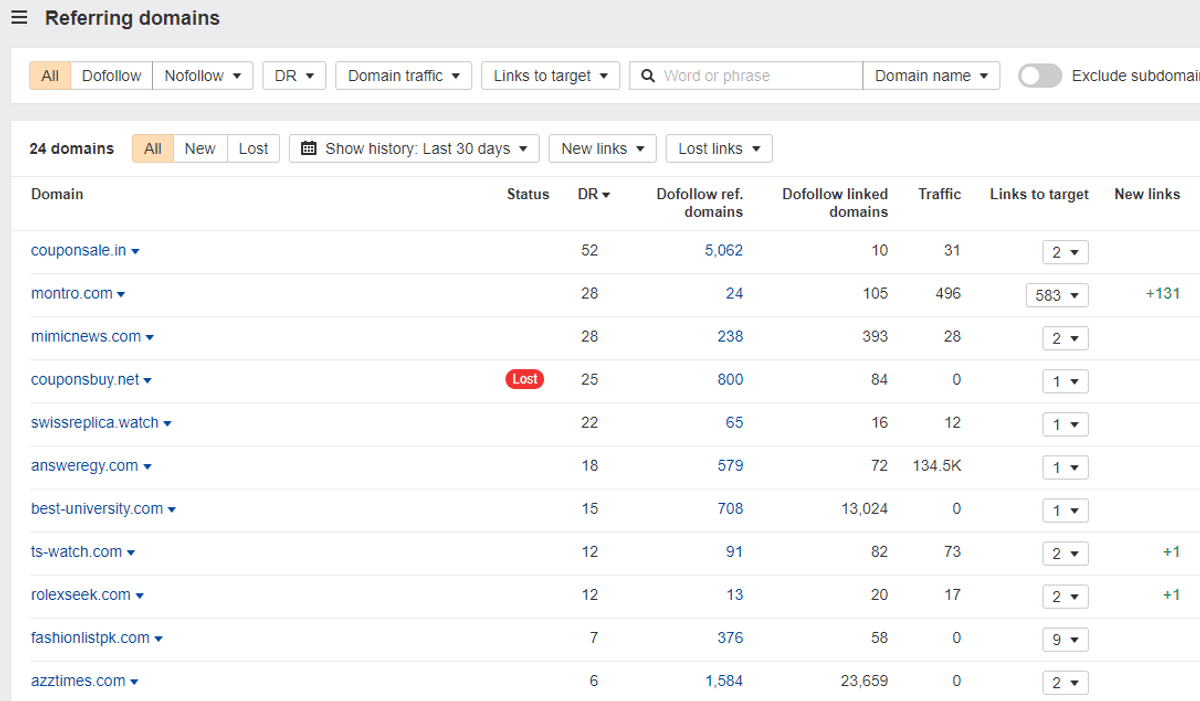
You can then filter this list based on your target domain or traffic. You can also remove any spam or irrelevant sites. Add any remaining sites to your list of prospects.
You can then perform these steps for each of the ranking pages with multiple links. This will leave you with a long list of link targets you can reach out to.
How to Use Your Link Prospect List
Once you have a list of link building prospects, you need to start the process of contacting these websites.
This is known as link building outreach, and it is a complex process in itself.
There are two routes you can go down when performing outreach:
Manual personalized outreach
Automated mass outreach
The first option is far more likely to succeed, especially with high-quality websites. But it can also be time consuming if you have an extensive list.
A good alternative to manual outreach is to break your prospect list down into smaller segments. You can then create personalized emails to target each group. You can use a tool like Pitchbox to create these emails.
We’d still advise you to use manual prospecting for your biggest link building opportunities, such as guest posts on high-authority websites. The high value of these links is usually worth the extra effort.

